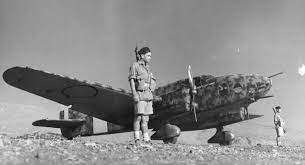
The Caproni Ghibli Ca.309 was a twin-engine multi-role developed by the Caproni Aeronautica Italy Bergamo (CAB) in the second half of the thirties. It was intended for armed reconnaissance and liaison and served with the Royal Air Force in the colonies of North Africa in the first phase of the Second World War.
Caproni CA 309 Developmental
Designed by engineer Cesare Pallavacino, he resumed the lines of the Caproni Ca.308 Boreas, his previous project. The Ca.309 was a monoplane with a twin-engine low-wing with a mixed structure. The fixed gear was mounted under the front legs of the two gondolas in-line engines Alfa Romeo 115-II and had wheel fairing.
Caproni CA 309 - Operational Use
The first units began to equip the squadrons of the Royal Air Force in Libya in 1937, replacing the biplane IMAM Ro.1. With the outbreak of World War II, service 53 specimens, which were used for reconnaissance (in particular Integrated Companies in self-Saharan aviation) and interdiction operations against land vehicles from British exploration. The Ca.309, in fact, had two wing machine guns, a swivel in the nose, and a bomb load of 330 kg. The Ca.309 was also used in operations in defense of Oasis Giarabub, Kufra, and Giallo.
In July 1942, the Ca.309 collaborated effectively to the reconquest of Giarabub and the storming of Siwa. At this stage, the “Ghibli” is in charge of the 12th Squadron APC (Airport Ajdabiya), at 103 ª (measured) and the 104th Squadron (Mellaha) of 10 Group APC, the 26th Squadron Aviation Saharan airport (Hon): not more than a dozen aircraft ready for use.
At the end of 1942, with the loss of Libya, the aircraft that remained were repatriated to Italy, where they were used as transport aircraft and connections.
In 1947, he was still in service at the last Ca.309 Squadron Connections.
Technical Description
The Ca.309 Ghibli was a conventional-looking aircraft made of composite, twin-engine, low-wing monoplane with a fixed cantilever.
The fuselage was made of mixed media before the welded steel frame was covered with a light alloy plate that went with a welded steel structure covered centrally in canvas and painted on the rear wood. The design incorporated the cockpit with two seats side by side, in the last series equipped with dual controls, which continued in a rear compartment for six passengers, cargo, and cargo and war, in reconnaissance missions, the planimetric and panoramic cameras. Rear-ended in a classic single fin, it comes with horizontal planes and a cantilevered wooden structure with metal armatures revisit plywood or painted canvas.
The ‘wing, mounted low and cantilevered and tapered plant, consisted of a two-spar wooden structure with metal reinforcement, covered with plywood and painted canvas. The control surfaces consisted of the two ailerons and flaps in the ventral, both made of wood with metal plates and covered with canvas.
The landing gear was a bicycle fixed front and back housing with independent wheels, with struts positioned under both engine nacelles, integrated rear by a wheel bearing swivel, not retractable, which is located under the tail.
The drive was carried out by a pair of motors Alfa Romeo 115-II, a 6-cylinder in-line inverted air-cooled capable of expressing an output of 200 hp (147 kW), located in many gondolas positioned on the leading edge and matched two-bladed propellers, wooden or metal, variable pitch in flight.
The defensive armament consisted of two machine guns caliber7.7 mmBreda-SAFAT positioned in the wing root with 500 rounds per gun complemented by a Lewis gun caliber7.7 mm swivel with 500 strokes, located on the front of the muzzle. That offensive consisted of bombs falling and clips for a maximum load of 336 kg placed in the fuselage.
Curiosities
The name Ghibli was then given to another Italian aircraft, the ‘Aermacchi / Embraer AMX light fighter, which entered into service in the second half of the eighties.
The name of this plane was the inspiration for the Japanese director Hayao Miyazaki, who called his animation studio Studio Ghibli in honor of this aircraft.